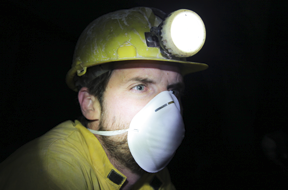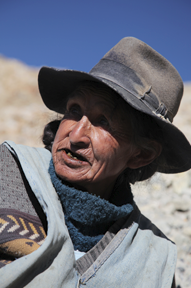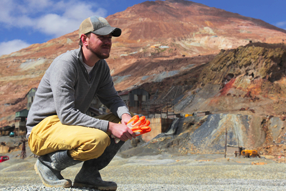Dear Friends, Greetings in the Lord. We want to thank you for your prayers over the last month, as they have opened the door for the gospel in an area that has been held in darkness. It is with your help that we tread new paths and deliver the message of hope, so please continue in every way.
This month we would like to share about our time in Potosi, Bolivia. Potosi is a high altitude town (13,500 feet) in the southern regions of Bolivia. At first glance, when one arrives, you would think it was just like any other Bolivian town, but Potosi has a history that literally shaped the course of the world.
In 1546, the city of Potosi was founded, and by the end of the 16th century it was the richest city in the world! How, one might ask? —Silver. There is one distinctive geographical feature that separates Potosi from any other city, and that is the towering mountain that sits above it called Cerro Rico (Rich Mountain). The mountain of Cerro Rico was the richest silver mine in the world from 1560-1800. It was the breadbasket of the Spanish Empire and where the majority of the Spanish wealth was derived. Ever wonder where Spain got their money to build the mighty Spanish Armada? Answer—Cerro Rico.
By 1672, a mint was established, in Potosi, to coin silver and water reservoirs were built to fulfill the growing population's needs. At that time, more than eighty-six churches were built and the city's population increased to nearly 200,000, making it one of the largest and wealthiest cities in Latin America and in the world. At that time, Potosi had a larger population than Paris, Madrid, or London.
Unfortunately, such wealth came at extreme costs. Over eight million people were killed by forced labor in the mines and the religious manipulation of the Spanish Catholic Church caused effects that still keep the people of Potosi in darkness.
Now jump ahead to Potosi 2009. Arriving in the city of Potosi you immediately see the view of defunct colonial churches and the towering sight of Cerro Rico. The mines are still worked today, mostly by locals who brave the deep tunnels to extract silver by hand. Our mission was to minister to the miners of Cerro Rico and bring the gospel to Potosi. There are no foreign missionaries working in Potosi and the spiritual climate is very dark.

One story we heard, before we entered the mines, was the active worship of the devil inside Cerro Rico. The history behind this was shocking. It all started when the Spanish felt it necessary to motivate the slaves that worked the mountain. So, Spanish authorities created a god that the slaves could worship inside the mines. Also, because they deemed slaves less than human, standard Catholic Christ and Mary worship weren’t a consideration. The Spanish thought the slaves (many of them darker skinned Africans and local Indians) were sons of the devil, so they ought to worship Satan, as they were already damned to hell anyways. The Spanish told the miners these demon idols were God. In the Spanish language God is called Dios, but the local Indians couldn’t pronounce the letter D so they quickly called the idols Tio. Or El Tio, which means, The Uncle in Spanish. When we traveled deep inside the mines we came across the Tio idols and witnessed the miners who still worship them as God. We saw Tio idols dating as far back as the 16th century. So with all that back-story our mission was set to bring the truth.
Five separate days we moved deep inside the mines sometimes traveling as far as 4km and crawling through openings only 18-inches. The gases, silica and asbestos caused us to cough uncontrollably at times, and certain mine shafts that we entered were over 100 degrees in temperature. The detonations of dynamite kept us all on edge and it wasn’t hard to see why most miners only last 10-15 years in these conditions. But the biggest killer inside the mines isn’t explosions or tunnel collapses, but lung disease and toxic fumes.

As we traveled deeper and deeper every day we delivered gospel tracks and small $2 solar powered radios tuned to a Bolivian gospel radio station to each miner we came across. We also talked with miners in small groups as they chipped away at the rock. One man we talked to was killed 6-days later when toxic gases overcame him in the very area we chatted. This might have been the only chance for him to hear the gospel. Outside the mines we also ministered to women who sorted through the rubble looking for discarded minerals (women are not allowed to work inside the mine because it is considered back luck). In one circumstance we ministered to two elderly ladies. One of the ladies was 81-years old and had worked outside of the mines picking through rocks for 50 years. She told us she made .20 - .50 cents a day for her work. We prayed and shared the word with them and they were grateful to hear the gospel. They were also thankful to receive the small gospel radios and turned them on right away.
In our travels to Bolivia we found an area with a rich and dark history that once was the center of the world. But today this area has been forgotten. We need more laborers to be sent into the harvest. If a city like Potosi, which was once the largest and richest in the world, could be forgotten, no city in the world is safe. We must speak the message and be bold to take the gospel everywhere.
Your prayers and support have enabled us to reach places like Potosi and establish the beginnings of something great with the local ministries in Bolivia. We will need your support more than ever as our next mission will bring us to an uncontacted tribe in Peru. The journey will be long and difficult, but with your prayers, a hedge of protection is around us and with your giving we have the means to make such journeys. Please consider supporting Travel the Road through a one-time gift or monthly donation. Your support is critical and we need it more than ever, as together we attempt to complete the great commission.
In Him,
Tim and Will

